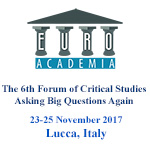Euroacademia Conferences
 Europe Inside-Out: Europe and Europeanness Exposed to Plural Observers (9th Edition) April 24 - 25, 2020
Europe Inside-Out: Europe and Europeanness Exposed to Plural Observers (9th Edition) April 24 - 25, 2020 Identities and Identifications: Politicized Uses of Collective Identities (9th Edition) June 12 - 13, 2020
Identities and Identifications: Politicized Uses of Collective Identities (9th Edition) June 12 - 13, 2020 8th Forum of Critical Studies: Asking Big Questions Again January 24 - 25, 2020
8th Forum of Critical Studies: Asking Big Questions Again January 24 - 25, 2020 Re-Inventing Eastern Europe (7th Edition) December 13 - 14, 2019
Re-Inventing Eastern Europe (7th Edition) December 13 - 14, 2019 The European Union and the Politicization of Europe (8th Edition) October 25 - 26, 2019
The European Union and the Politicization of Europe (8th Edition) October 25 - 26, 2019 Identities and Identifications: Politicized Uses of Collective Identities (8th Edition) June 28 - 29, 2019
Identities and Identifications: Politicized Uses of Collective Identities (8th Edition) June 28 - 29, 2019 The European Union and the Politicization of Europe (7th Edition) January 25 - 26, 2019
The European Union and the Politicization of Europe (7th Edition) January 25 - 26, 2019 7th Forum of Critical Studies: Asking Big Questions Again November 23 - 24, 2018
7th Forum of Critical Studies: Asking Big Questions Again November 23 - 24, 2018 Europe Inside-Out: Europe and Europeanness Exposed to Plural Observers (8th Edition) September 28 - 30, 2018
Europe Inside-Out: Europe and Europeanness Exposed to Plural Observers (8th Edition) September 28 - 30, 2018 Identities and Identifications: Politicized Uses of Collective Identities (7th Edition) June 14 - 15, 2018
Identities and Identifications: Politicized Uses of Collective Identities (7th Edition) June 14 - 15, 2018
Monstrosity, Uncanny Replication, and Family Values in Tom King’s and Gabriel Hernandez Walta’s The Vision
-
-

-
Presentation speakers
- Tiffany Hong, Department of Languages, Linguistics, & Literatures, Nazarbayev University, Astana, Kazakhstan
Abstract:
Tom King and Gabriel Hernandez Walta’s 2016 twelve-issue limited series The Vision situates the Avenger’s legendary synthezoid and his family in the suburbs of Arlington, Virginia. The dissonance between this sinisterly mundane setting and the increasing fragmentation of his synthezoid children and wife – who instinctively and defensively murders a human attacker in the first issue – serves as the unsettling tempo of a graphic narrative that interrogates the representation of humanity as only sequential art can. The Vision’s patriarch and Frankenstein figure – simultaneously doctor and creature – attempts to replicate his failed family with the Scarlet Witch, fashioning a wife and children who are nascent beings, reliant on him and their suburban environment for signals as to how to properly perform humanity. The comic – with its ordered rectangular frames (a variation on King’s signature nine-panel grid) corresponding to the Visions’ robotic, unnatural(ly) perfect diction and cadences – confronts the reader with humanity as affect, as imitation and manifestation. The Visions – particularly the geographically constrained (and named) housewife Virginia – struggle to assert their ontological imperative, their right to exist and in turn engender existence, in a community where unfamiliarity rapidly escalates to fear and hatred. The comic postulates a number of pairings in which the ‘copy’ must wrestle with the spectre of inferiority, and the fate of merely tracing out an impoverished trajectory of the predecessor’s life, in Vision/Ultron, Ultron/Victor Mancha (Ultron’s other, humanoid son), and Virginia/Scarlet Witch. The comic makes manifest the literary convention of foils through this literalized mirroring in a study of predestination, free will, and the cost of breaking from our creators. Their son Viv even identifies himself with Shylock in The Merchant of Venice, the writer and penciller establishing parallels between this robotic other and similarly marginalized (and visually distinct) ethnicities.
-
Related Presentations

Financial Crises snd Plurilateral Discourses
- Diana Bozhilova

A Brief History of the Inhumanities and Contemporary Humanities Studies
- William H. Bridge













